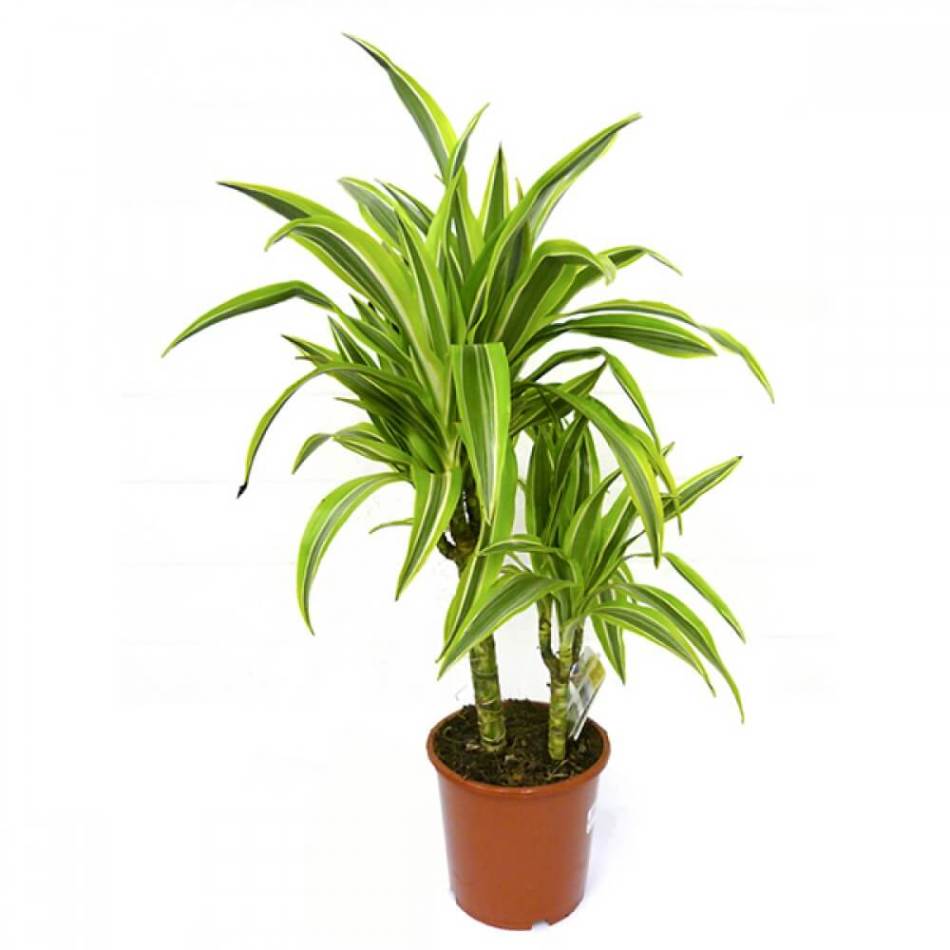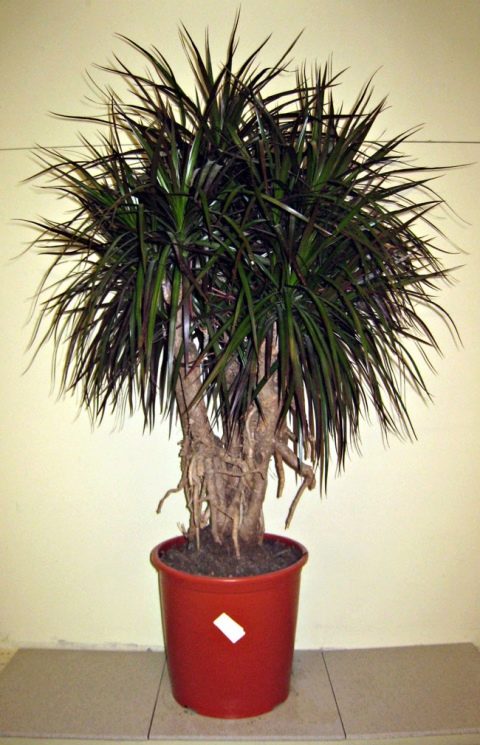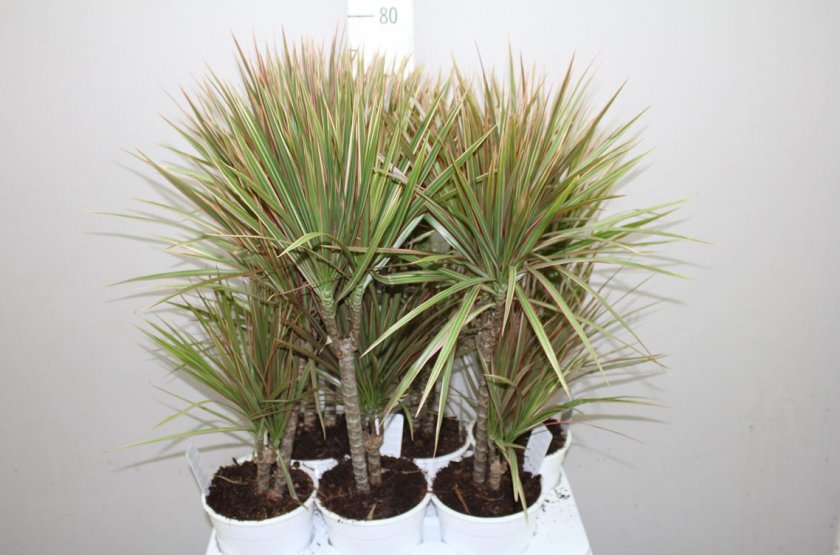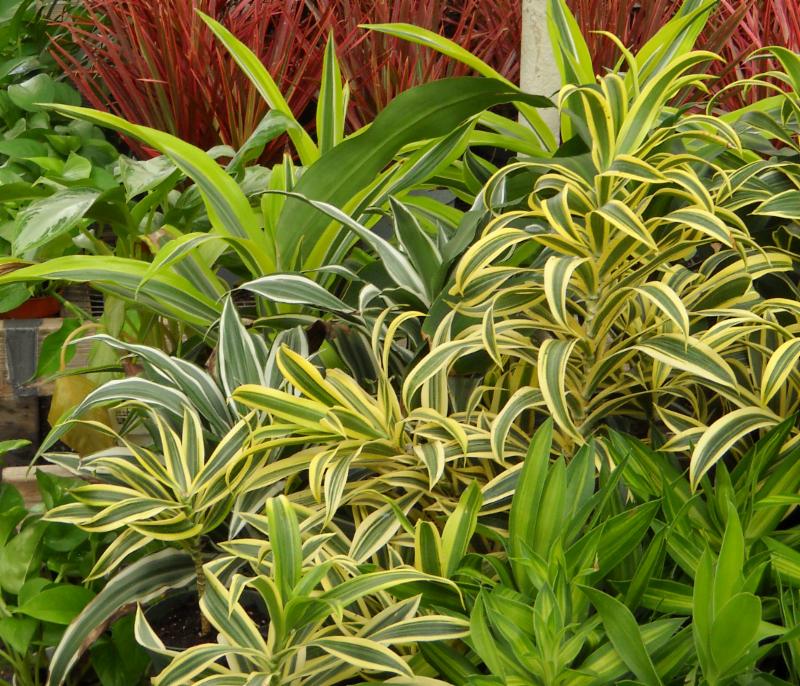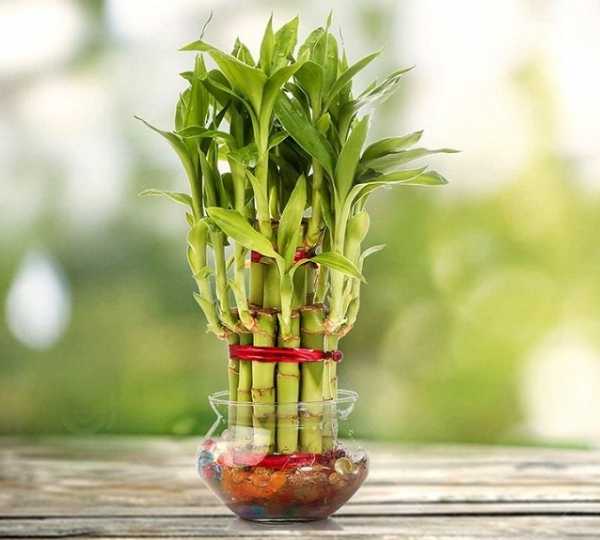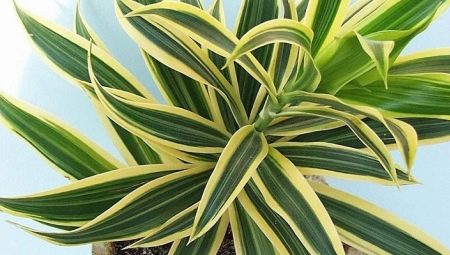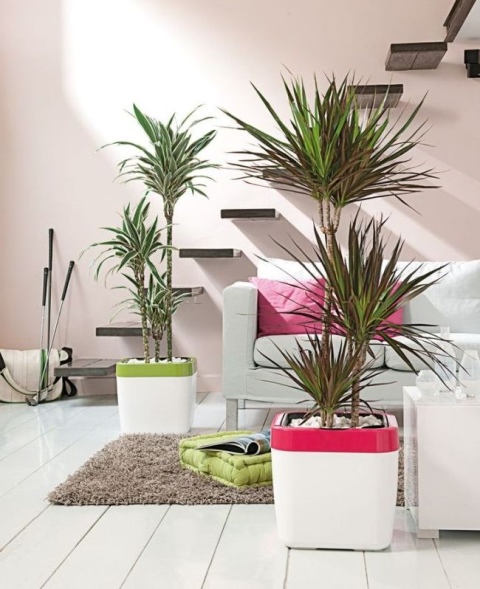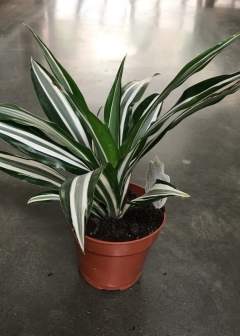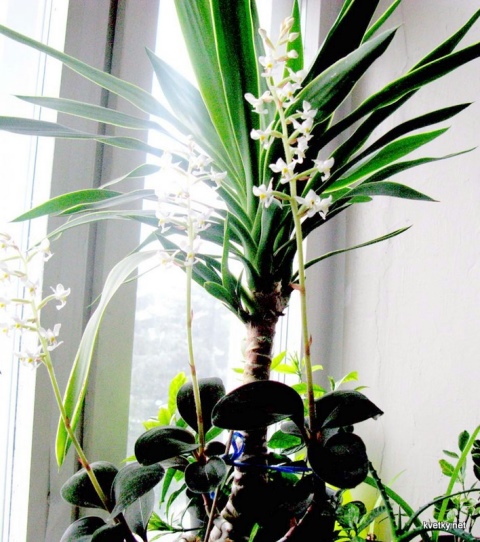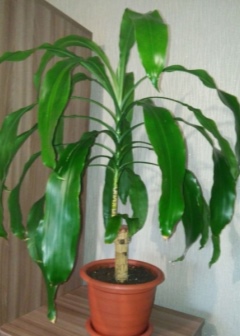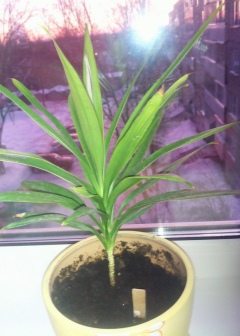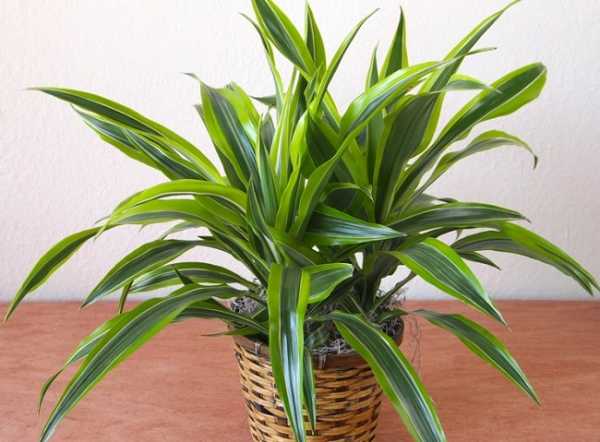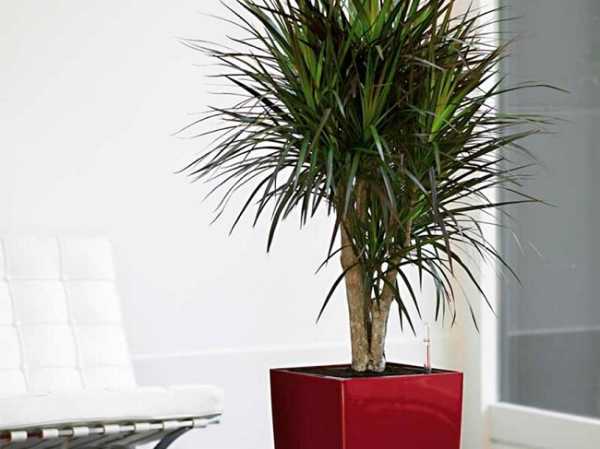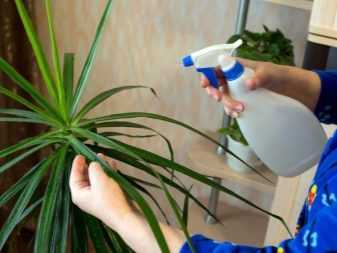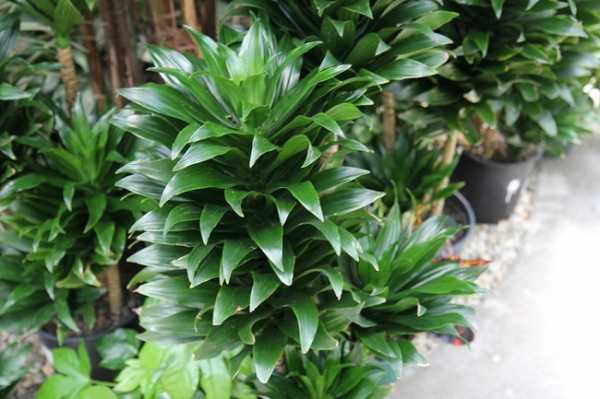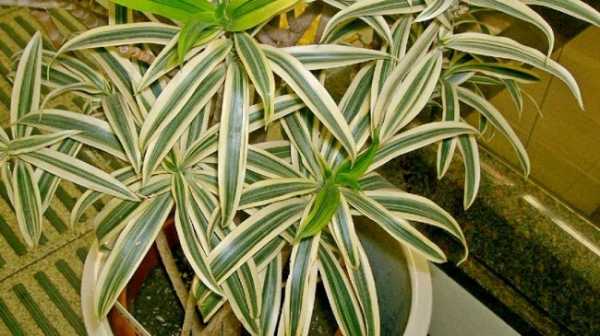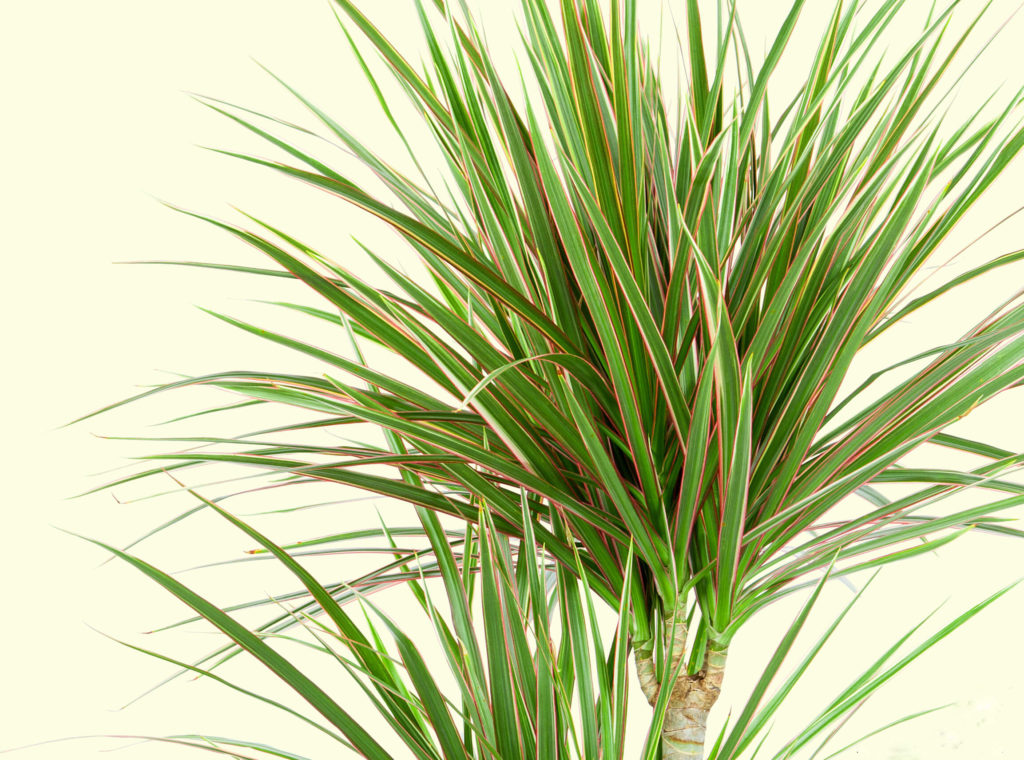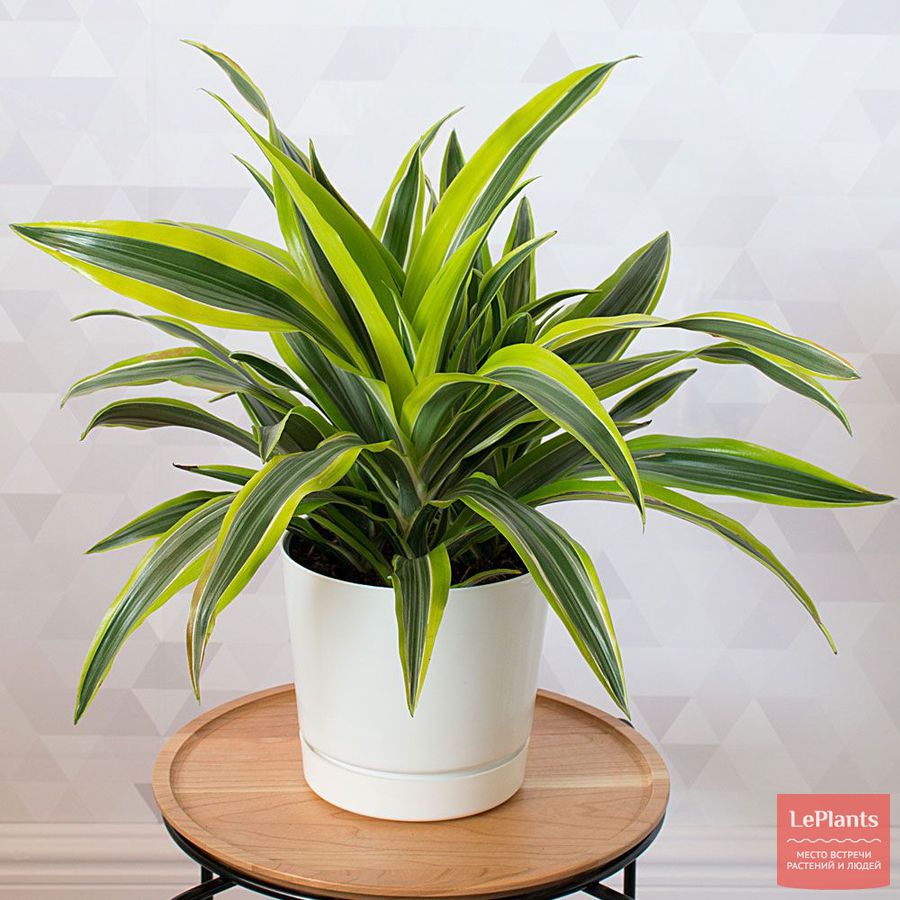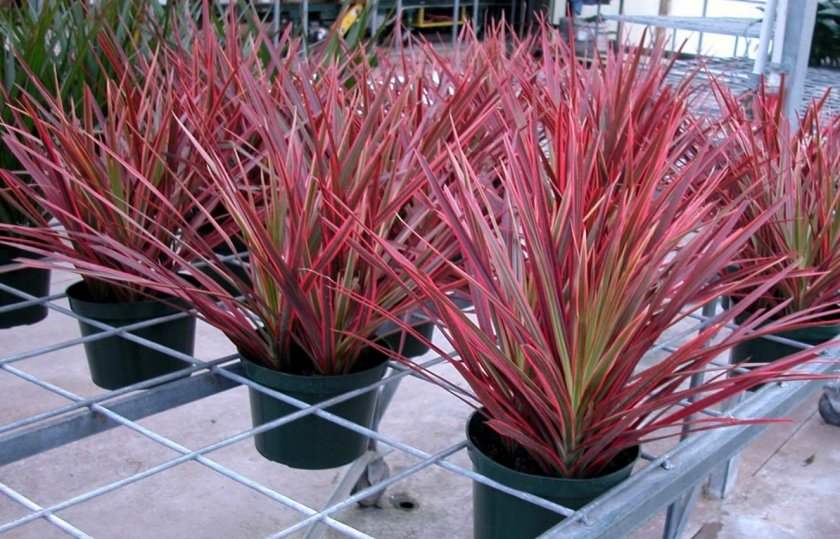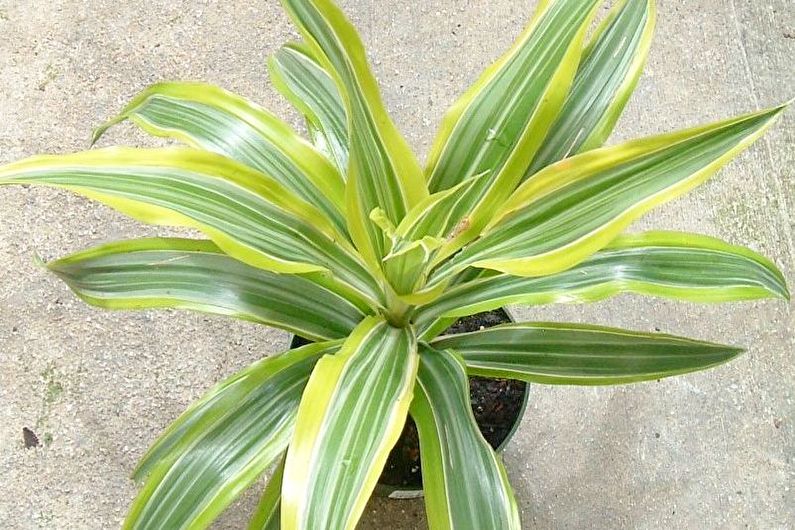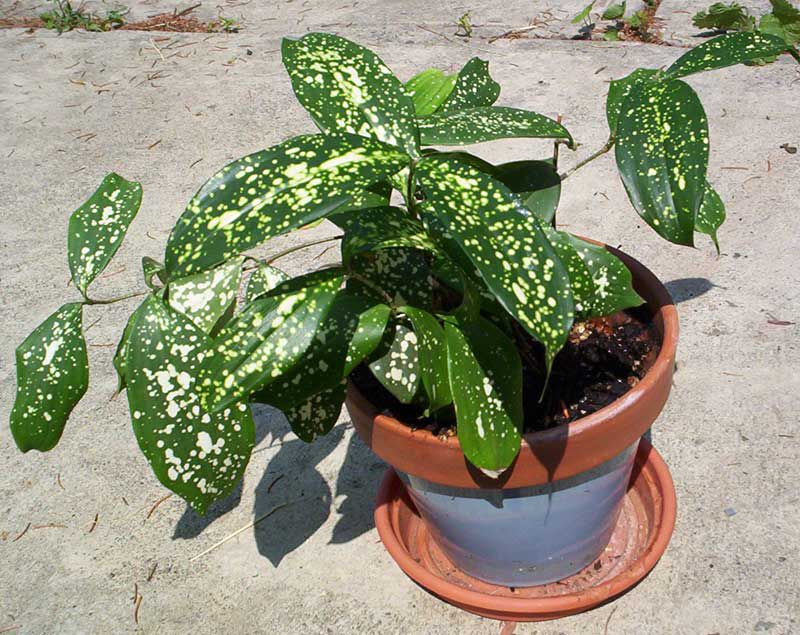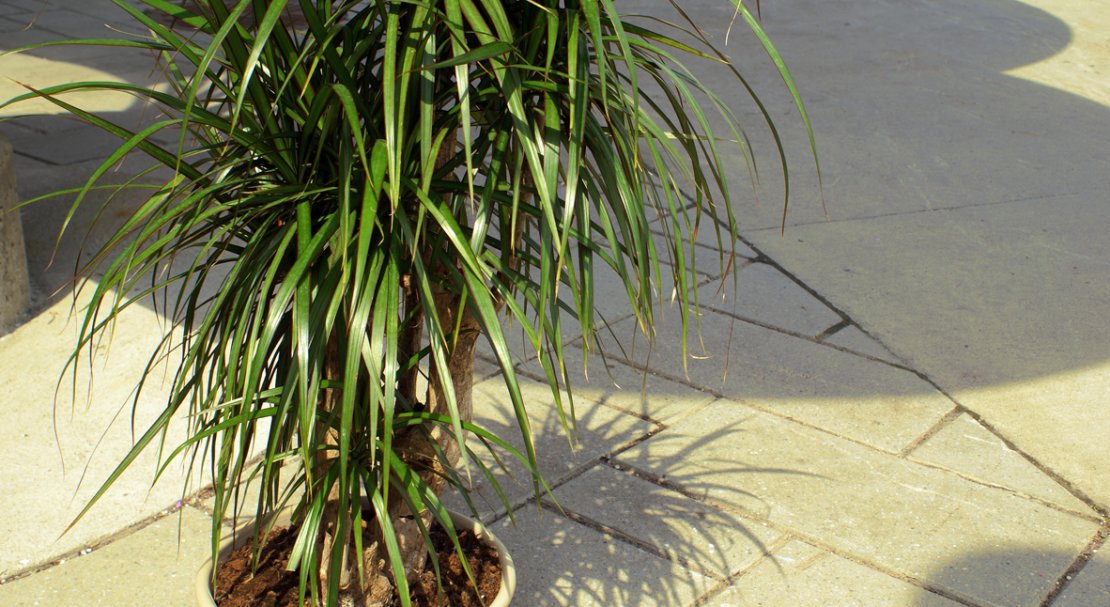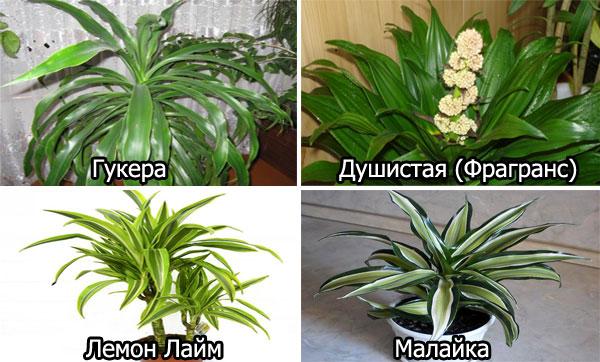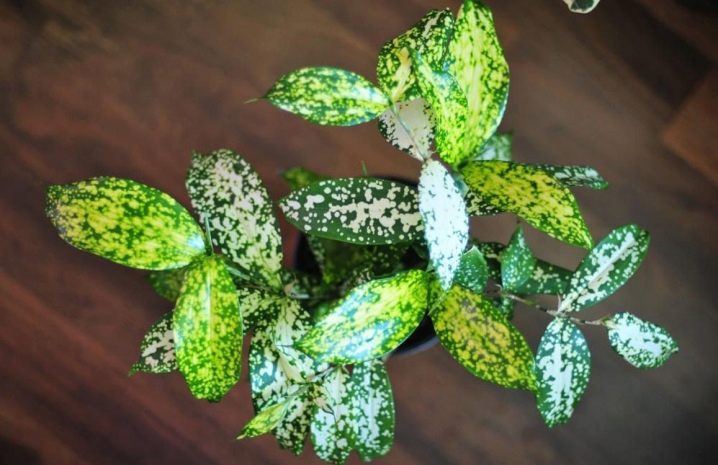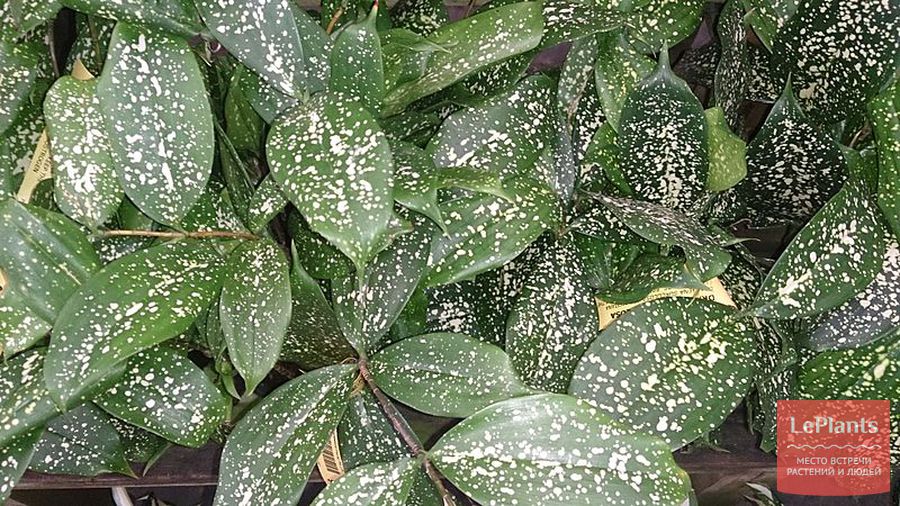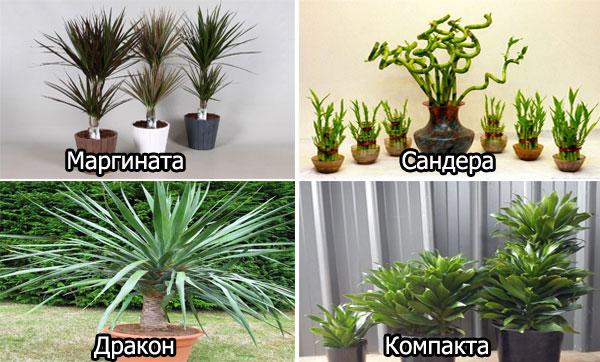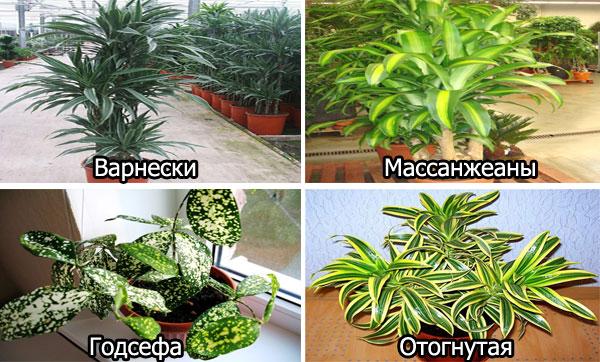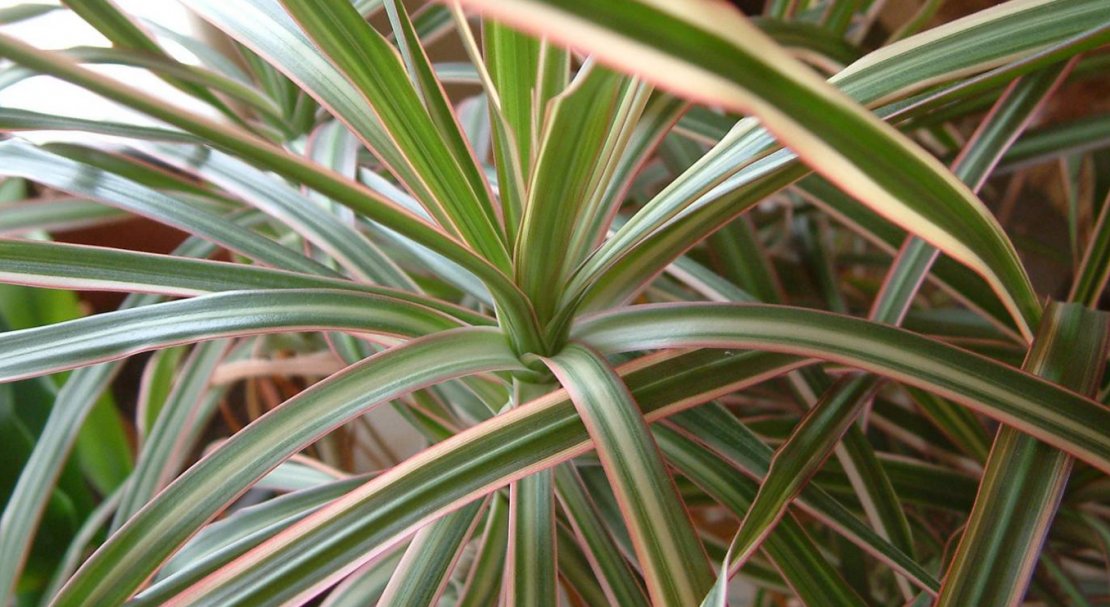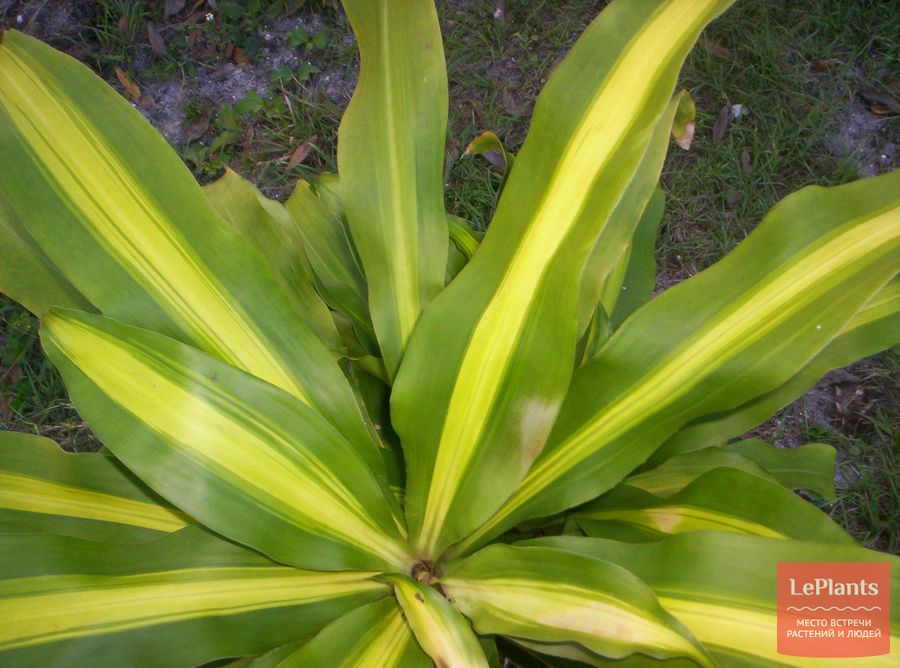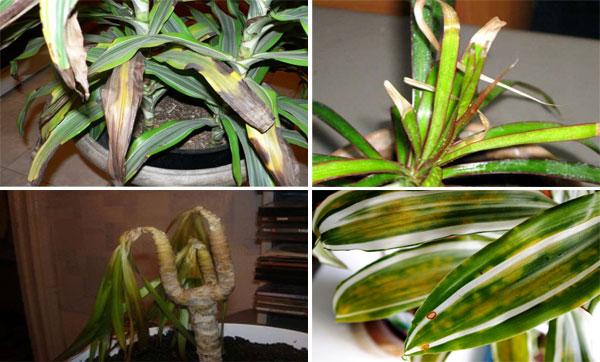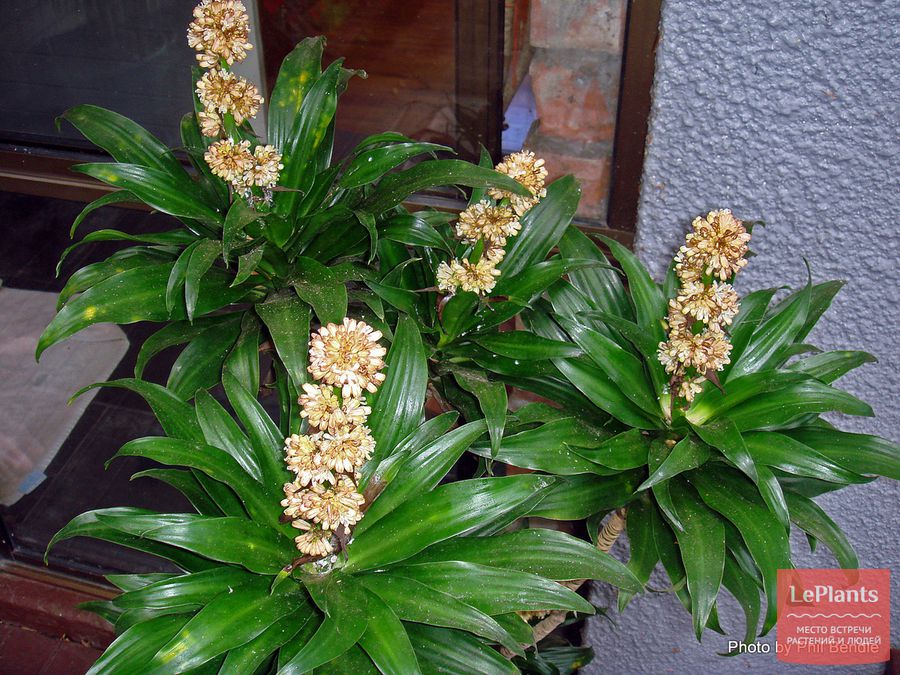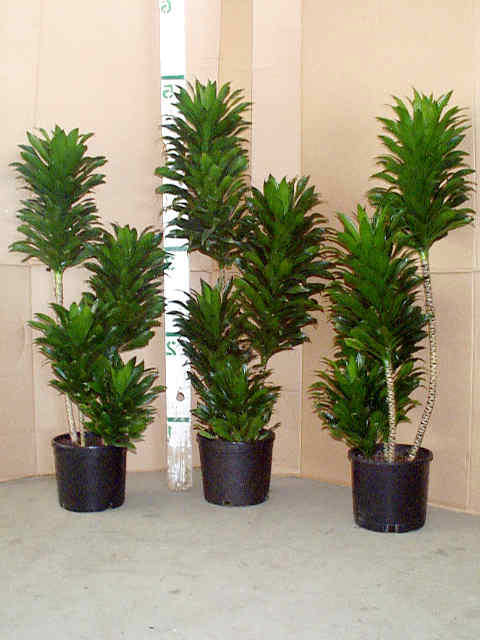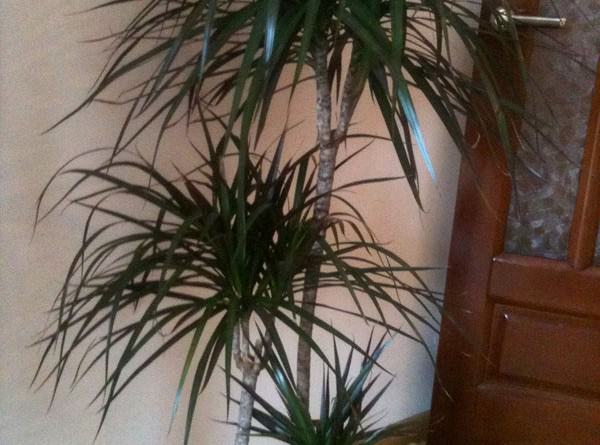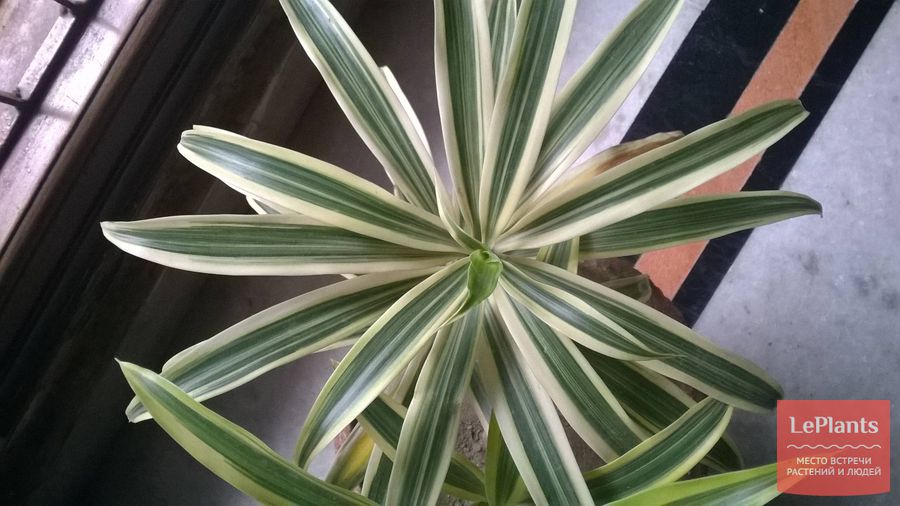Description of the types of dracaena, can it be kept at home and recommendations for those who want to buy it
The Dracaena false palm is a beautiful tropical plant belonging to the Dracaena family. Under natural conditions of growth, it can be found in the homeland of the plant: in Africa, Asia and the Canary Islands.
Let's figure out for a start what a dracaena or a tree of happiness looks like. It is a tree or shrub with straight stems and rosettes of elongated bright green foliage that can reach fifteen to seventy centimeters in length.
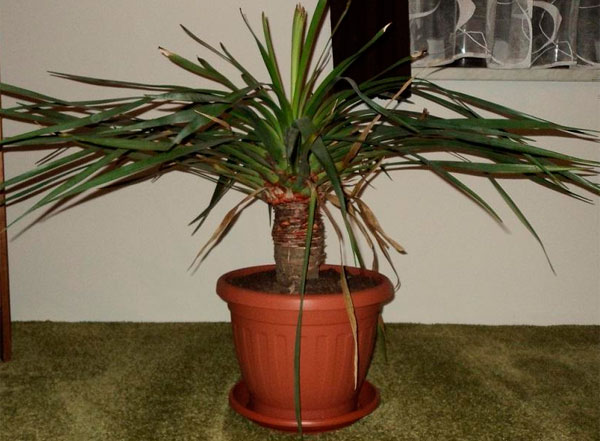
The height of the plant itself in natural growing conditions, depending on the species, can reach twenty meters, in indoor conditions it is certainly much less.
With the creation of optimal conditions of detention and proper care, the dracaena flower can live in the house for up to fifteen years. The plant blooms with small flowers of white or greenish color. At home, dracaena blooms very rarely, so many do not even know for sure whether it blooms at all. During flowering, it has to be taken out of the house (for example, onto the balcony), since the flowers emit a strong heavy aroma.
The word dracaena means a female dragon, the genus itself has more than one hundred and fifty species. In places of natural growth, a red resin (gum) is extracted from many varieties, which is called dragon's blood. Foliage fibers that look like bristles or horsehair are used to make brushes. Dracaena juice is used for the manufacture of varnish, which is used to cover metals, as well as for the production of dyes for fabrics and hair. It is also used to give wines a beautiful color and for medicinal purposes.
Purchasing a plant
Plants are best purchased from a reputable outlet (garden center, florist). Choose a plant with good leaves, no spots or other lesions that indicate the presence of pests. Do not forget about the root system, it must be healthy, without any lesions. If the plant is not signed and there are doubts as to whether we are dealing with cordilina, or yucca, the difference can be found by examining the roots, in dracaena they are yellow-orange, in cordilina they are white. It is better to quarantine the plant itself, so that in the presence of pests, thrips, scale insects, they do not master other ornamental plants.
General information about dracaena
Dracaena (Dracaena) evergreen to the genus of the same name Dracaena. Some botanists classify it as a member of the asparagus family, and there is still controversy on this issue.
South Africa is considered the homeland of the plant, but it is often found in the latitudes of South America, Asia and in some other regions. It is a tree-like shrub with rosette-like leaves. Some tree species can grow up to 2-3 meters in the wild. But there are also dwarf varieties that do not grow more than 30-40 cm. In total, there are about 150 species of dracaena in nature.
Not all varieties of dracaena bloom. Cultivated varieties, of which there are not so many, practically do not bloom at home. The tree itself with a fluffy, sweeping crown, very similar to a palm tree and leaves of an interesting striped color, is of decorative value.
The plant is often grown in large outdoor flowerpots and is an excellent decor for large halls, halls, offices, winter gardens. Some species can be grown outdoors, in gardens.
Reproduction
Domestic pandanuses reproduce in several ways: by shoots, cuttings, seeds and division.
By shoots
This method is not suitable for all pandanus.Shoots (they are also called babies) appear only on some types of palms. For example, the Useful variety does not give them. If children are present, then they are separated together with lateral aerial roots and planted in the soil.
Cuttings
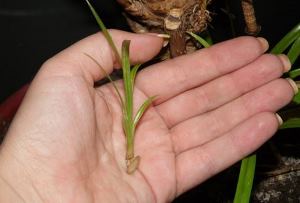 How to propagate pandanus by cuttings? It is necessary to cut cuttings about 20 centimeters long from the side branches, treat the wounds (cut points) with charcoal - activated or wood.
How to propagate pandanus by cuttings? It is necessary to cut cuttings about 20 centimeters long from the side branches, treat the wounds (cut points) with charcoal - activated or wood.
Plant the stalk in the ground, composed of peat and sand in equal quantities.
The shoots need to create a greenhouse - cover the top with a transparent film and maintain a temperature regime in the region of 25 to 30 degrees. The cuttings need to be ventilated periodically. To make the plant grow faster, take a root growth stimulant.
Seeds
The seeds are planted in the ground (sand and peat / leafy soil in equal proportions) and covered with foil. The temperature regime for this growing method is about 25 degrees. If all the conditions are met, the shoots will appear in two weeks. It is easy to care for them - you need to water in moderation and regularly ventilate. When three or more leaves appear on the sprout, it can be transplanted into a separate container.
By dividing
For reproduction by division, rosettes with roots of about 20 centimeters should be cut from the bush. For days, the rosettes are dried, then they can be planted in separate containers with a drainage layer (at least 2 centimeters) of coarse sand and clay shards. Another layer consists of turf (at least 7 centimeters), and the top is covered with washed river sand. The sprouts are immersed in moist soil and the earth around is compacted. You can maintain the bottom heating, and keep the temperature at 25 degrees.
How to care for a dragon tree?
One of the most unpretentious indoor crops, bordered dracaena, does not require special efforts from the grower. Plant care is simple. The bright artificial light of office premises is enough for her to feel great in any weather.
The problem of lack of illumination may arise for those who grow dracaena at home. Lack of light causes more chlorophyll to form in the leaves, which leads to a green color change. Care consists in providing the dracaena with bright and long-lasting (about 10-12 hours a day) lighting. In summer, you can put the dragon tree in a place protected from direct sunlight, near the west or east window. And in winter, the problem can be solved solely with the help of additional illumination of the plant with a fluorescent lamp.
Caring for a bordered dracaena cannot be called difficult. An unpretentious plant is great for home growing.
Young dracaena in a pot with a small decoration in the form of a ceramic doll.
This is especially dangerous for a plant that is at rest and at a low temperature in the room. In the warm season, at temperatures above 20 ° C, watering should be carried out when the topsoil dries out. In winter, it is necessary to halve the amount of water received by the plant in one watering.
The temperature regime for growing dracaena marginate does not require special heat or coolness. The plant feels good at temperatures that are comfortable for humans from 25 ° C to 15 ° C. These are the usual conditions of a city apartment or office.
Reduced air humidity in a centrally heated room negatively affects the appearance of the plant. With a humidity of already 60%, the ends of the leaves begin to dry out in dracaena, and then their edges. With prolonged exposure to dry air, massive yellowing and leaf fall can be observed. To avoid this, care in the form of frequent spraying with cool soft water or an increase in the overall humidity of the room to 70-75% helps. Dracaena will feel good, bordered next to a large aquarium or a decorative fountain, where it will need the most minimal care.
Home bordered dracaena grows in a small pot.Spreading leaves are difficult to distinguish from a palm tree.
A properly groomed dracaena, bordered with sunlight.
An important point is plant transplantation:
- the most suitable containers are tall, narrow containers in which a large mass of dracaena roots will comfortably fit;
- a young plant must be transferred annually into a larger pot, the diameter of which should exceed the previous one by about 10 cm;
- the composition of the mixture includes 1 part of turf, 2 parts of leafy soil and 1 part of sand;
- an adult plant needs to be transshipped every 2-3 years, as the container is filled with roots;
- transplanting a large dracaena is difficult, therefore, care should consist in an annual partial replacement of the top layer of soil 5-7 cm thick.
Low dracaena in a rectangular pot to decorate the veranda.
Tall dracaena bordered for office decoration.
Another relative of the bordered dracaena - sandera (bamboo of happiness), will also perfectly fit into the interior of any apartment or office.
Home care
Caring for dracaena is relatively easy. This is especially true for such varieties as edged and deremskaya, "Dragon".
Temperature and humidity
Being a southern plant, dracaena requires warmth, adherence to a certain temperature regime and maintaining sufficient air humidity. The optimum temperature for crop growth should be at least 20 degrees Celsius, the minimum - +160.
If the thermometer drops below +100 Celsius, the heat-loving plant can simply freeze and die. Seasonal changes in heat and cold, sharp gusts of wind are also undesirable.
Watering is required in moderation, without flooding the roots, so that there is no decay. It is best to combine watering with frequent spraying. The drained water remaining in the tray after the procedure is poured out immediately. Then moisture is removed from the inner pockets in the leaves, otherwise decay and foliage may begin to fall.
A variety such as "Godsefa" can be found in a room with relatively dry air. The rest of the species do well only in high humidity conditions, as they are tropical plants. In hot weather, when the pot is in a heated room, the leaves and trunk are sprayed at least three times a day.
You can also run over the sheets with a wet cloth.
Lighting
Light dracaena is necessary, but the tree must be protected from direct rays of the sun. If you put it in the back of a well-lit room, close to the window, it will be a great place. You can also leave it on the windowsill, but on the east or west side.
Light and unevenly colored leaves require more light than dark ones. Therefore, the varieties that possess them are more demanding in care.
Top dressing
Growth is noticeable from spring to autumn; in winter, the process stops. Therefore, the culture is fed mainly from April to October. You need to purchase mineral fertilizers in specialized stores, apply according to the instructions. As a rule, feeding is required once every two to three weeks. In order for air to penetrate into the ground near the roots, the soil of the upper layer is loosened.
Watering
The soil in the tub is left slightly moist, but not filled with water until it becomes a swamp. Standing water from the tap, quite warm (+ 25-300 Celsius), will do. In cold weather, it is heated.
Youngsters are transplanted every spring into flowerpots with a diameter of 20 cm. The soil is the same as for palm trees, with a drainage layer. Water the plant with a stimulant after planting.
In the course of growing a crop, flower growers sometimes have problems - the appearance of the foliage changes. This signals a lack of light, moisture, heat, or an excess of them.
- The leaves become soft and begin to curl. This happens if the temperature regime is not observed (dracaena froze). You need to move the pot from the windowsill or floor to a place where it is warmer and more light.
- The edges of the leaf become brownish in color.This indicates that the plant is standing in a draft or the air in the room is not humid enough. In this case, you need to place the dracaena in a calm place, protected from cold air currents. Spraying will help completely restore the appearance.
- Light spots appear. This means that there is too much light - the intensity of the radiant flux must be reduced. It is necessary to shade the tree, remove it from direct sunlight.
- The lower leaves turn yellow and fall off. The process of dying off aging foliage and replacing it with fresh light green shoots is natural.
Plant care involves the constant removal of withering leaf blades.
Dracaena fragrant (Dracaena fragrans)
This species belongs to evergreen ornamental plants that have beautiful leaves and long stems. In nature, it can grow up to 7 meters, however, when grown at home, its growth does not exceed two meters. The leaves are large, have an arcuate convex shape, about 60 cm long. The upper part of the leaf is smooth and shiny, about 10 cm wide, mostly green, uniform in color, but sometimes it can have stripes or edging of yellow, light green or white. The edges of the leaf are wavy with a clearly visible central vein. A distinctive feature of this variety is that its flowers have a pleasant concentrated aroma, similar to the aroma of freshly cut grass. It blooms with snow-white or light green flowers of small size, which are attached to a long - about a meter peduncle and are combined into a dense inflorescence. The flower stalk grows from the middle of the deciduous rosette, the flowers are honey plants, attract small insects with their aroma, however, growing in living conditions such a dracaena rarely pleases with flowers. This type includes varieties of fragrant dracaena, which have green, variegated leaves, a long thick trunk, which needs additional support due to its instability. Such dracaena depletes a pleasant aroma from all its parts. It does not have a peduncle, it blooms extremely rarely. In nature, it blooms large flowers up to a meter high.
Fragrant dracaena has several subspecies, differing from each other in color and size of leaves, as well as in the height of the trunk. Some gardeners call the fragrant dracaena the tree of happiness. You can often see souvenirs from the stems of this palm tree in garden shops, the upper cut of which is treated with paraffin, and when this stem is rooted, you can grow Dracaena Fragrance.

Dracaena Dracaena (DracaenaDeremensis)
This type of palm belongs to the slow-growing low plants, which is native to tropical Africa. In nature, it grows up to five meters. Growing up in room conditions, it does not even reach one and a half meters. It is characterized by a thick, straight-growing trunk, which lignifies after several years and is covered with decorative leaves up to a meter long and up to half a meter wide. Leaves are sessile, elongated, xiphoid, shiny, sag down as they grow older. It is considered the tallest representative of this species. Growing up to three meters at home. The stem of the palm is thick, not branched, does not grow lateral branches. The leaves have a tricolor color, which gives the whole palm tree a very decorative look.
Under ideal growing conditions, the Derem Dracaena blooms with beautiful dark red flowers with a snow-white center that have a strong unpleasant odor. When growing, you should regularly wipe the leaves of the plant, as well as irrigate them, since the flower does not react well to dustiness. Derem dracaena belongs to heat-loving plants and loves to be grown at a temperature of 20-22 degrees. It is propagated by cuttings, which take root for one and a half to two weeks, and when using preparations for rooting, the cuttings grow roots in a week.

Dracaena varieties
- Dracaena bordered (Dracaena Marginata) - this species is the most unpretentious type of dracaena, characterized by thin leaves with sharp ends, up to 70 cm long and bare trunk. Practically does not branch (only after pruning), blooms very rarely in the house. The most common variety is Basic Green, with a thin raspberry stripe along the edge of the dark green leaf. But there are many other variegated varieties: with stripes of pink, cream, light green and golden colors.
- Dracaena reflexa (Dracaena reflexa) - This dracaena is native to Madagascar, grows in the form of a bush, branches well and has short, wide leaves. It blooms very rarely. It is considered the most demanding type of dracaena. Fun fact: The plant is being used by NASA for research to remove formaldehyde from the air. One of the most popular varieties is the Song of India, with variegated leaves arranged in a spiral, on the edges of which there are wide yellow stripes.
- Dracaena sanderiana - also known as "lucky bamboo". Often sold in supermarkets with twisted stems. In fact, this shape is artificially given to the plant; at home, this pseudo-bamboo will simply grow upward. He can spend some time in water, but then the plant should be transplanted into a pot with soil, otherwise the lower leaves will begin to turn yellow and crumble. There are varieties with solid leaves, with a white border around the edge and a white stripe in the center of the leaf.
- Fragrant dracaena (Dracaena fragrans) - has very beautiful wide leaves with a yellowish stripe in the middle. The stripe appears only in diffused light, and disappears in bright light. Prefers a warmer place than other types of dracaena: at least 17-20 degrees. There are many varieties with different arrangement and color of the stripes on the foliage. The leaves are very tender, it is not advisable to spray this variety. The plant can bloom indoors. The flowers are very fragrant with a strong honey scent. Until now, disputes about the difference between fragrant and deremskaya dracaena do not subside, sometimes they are referred to the same species: fragrant dracaena grows faster, its leaves are larger than that of deremskaya dracaena.
- Dracaena Godseffiana or Dracaena Surculosa is a shoot-forming dracaena, very different in appearance from other plants of its family. It is similar to aucuba and croton, which is why they are often confused. Leaves are spotty, spots can be from white to yellowish-green. Dark-leaved varieties are shade-tolerant, light-leaved ones require brighter lighting. In spring, this dracaena blooms; by autumn, red berries may appear on it. It is rarely found in home floriculture.
There are other varieties of dracaena, but they are practically not common in indoor floriculture.
Dracaena pests and diseases

Pests
Dracaena, growing at home, is quite resistant to pests. However, scale insects, aphids, mealybugs, thrips and spider mites can still settle on it. If any of these pests settle on the plant, then it can throw off the injured leaf plates. If there are few pests, then you can try to get rid of them with a soap solution, they should regularly wipe the surface of the foliage and stems. If spider mites have settled on the plant, then a hot (about 50 degrees) soap solution is used to wipe it. When the dracaena is wiped with this solution, it should be treated with a suitable insecticidal agent.
Yellow foliage

The yellowing of the leaf blades in the lower part of the bush is a completely natural process. Each leaf plate lives on average for 2 years. Old foliage dies slowly
And if the yellowed plates spoil the appearance of the bush, then just carefully remove them and that's it.
Yellowing of young leaf plates should cause alarm. This means that you are watering the bush incorrectly.Remember that you need to moisten the substrate immediately after it dries to a depth of 20-30 mm, no more. Do not overdry the earth lump.
Why dracaena dries
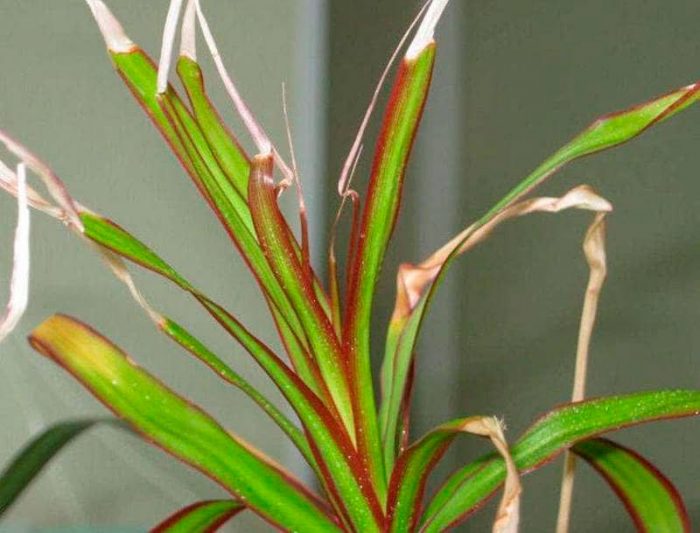
If the edges of the foliage begin to dry, and the tips turn brown, then this indicates excessively dry air in the room. Moisten the plant systematically with a spray bottle.
If the bush has not been transplanted for 3 or 4 years in a row, then salts may accumulate in the soil mixture, which prevent the root system from fully absorbing nutrients. In some cases, the tips of young foliage may begin to blacken and dry out due to an excessive amount of fertilizer applied to the substrate. In this case, the soil mixture becomes unsuitable for further growth and development of the bush, while the suction roots die off. In this regard, if the bush begins to dry out, but at the same time you water it well, you should definitely completely replace the soil mixture.
Dracaena leaves turn yellow, dry and fall. Top reasons and helpful tips
Why does rot appear

As a rule, initially rot appears at the top of the leaf plate, and then gradually begins to spread further. Rot may appear due to bacteriosis, which is an infectious disease. And the reason for this can be poor lighting, low air temperature and regular stagnation of moisture in the substrate. An excessively dense structureless or heavy substrate can also lead to this. By eliminating the existing problems and cutting off the affected foliage, you may be able to save the plant.
With bacteriosis, decaying wet spots appear on the leaf plates, while a yellow strip passes between the decayed and healthy tissue. A sick dracaena is unlikely to be cured. Bacteriosis can develop for the following reasons: excessively high humidity, high air temperature, lack of phosphorus and potassium, and still too alkaline substrate.
Why dracaena falls
It has already been mentioned above why foliage can turn yellow and fly around. However, it also occurs when the leaf plate suddenly becomes faded, loses its turgor, and then dies off. The reason lies in the fact that the dracaena was exposed to too low an air temperature, or rather, it was frozen. Transfer the bush to a warm place and moisten it with a spray bottle using warm water. It is recommended to transplant the bush into a fresh substrate, while cutting out all rotten roots. You can also save the dracaena by cutting off and rooting its upper part.
If moisture systematically stagnates in the substrate, and the earthen lump is supercooled, this can also lead to leaves flying around, since rot appears on the root system. Then the stem also rots. Therefore, you can try to save the bush by cutting off the healthy parts of the stem from it and rooting them.
Also, this culture can get sick with such infectious diseases as: alternaria, light brown spot and phyllosticosis. As a rule, this happens with old bushes, which are poorly looked after. To cure a sick bush, it is recommended to treat it with a solution of a fungicidal preparation, for example, 2 grams of Fundazole for 1 liter of water. You need to spray the bush three times with a break of one and a half weeks.
How to save dracaenawhen the leaves fall? | ...

